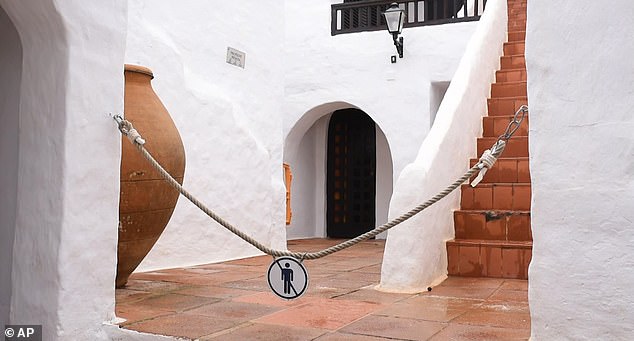A popular Menorcan resort known as ‘The Mykonos of Spain’ has blocked its streets to prevent tourists from taking selfies in the latest attack on tourists.
The 195 owners of Binibeca Vell have said they do not want visitors before 11am and after 8pm, as anti-tourist signs tied to thick ropes and chains have been hung throughout the holiday resort.
Locals have complained about rowdy tourists disrespecting private property by climbing ladders, scaling picture-perfect balconies, and even breaking through doorways while searching for the most Instagrammable spots.
Binibeca, known for its whitewashed houses and winding paths, can only accommodate 500 permanent residents in summer, but each year some 800,000 tourists crowd its pristine alleys.
But recent images show the idyllic city almost completely deserted, as several alleys have ropes and chains hanging between the entrances with round signs indicating no trespassers.
A popular Menorcan resort known as ‘the Spanish Mykonos’ has chained its streets to prevent tourists from crowding them while taking selfies.
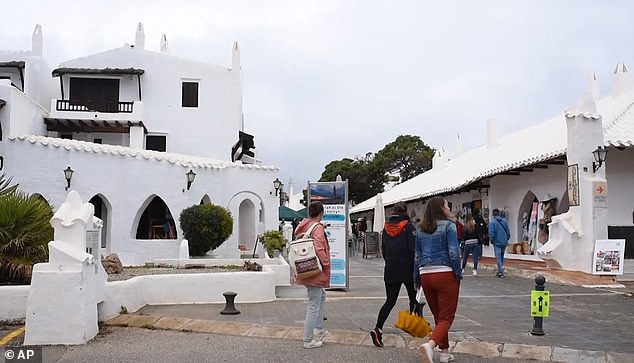
Binibeca Vell is a popular holiday destination due to its winding streets and whitewashed houses.
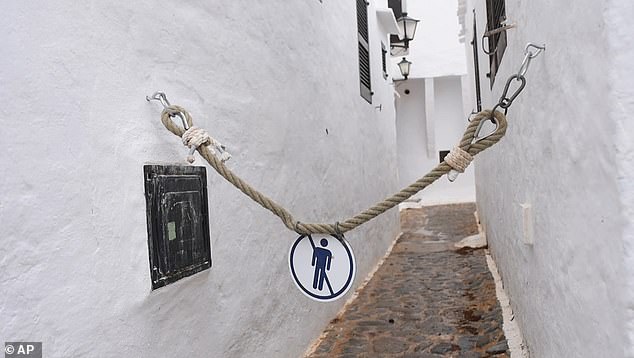
Angry locals have put up rope and chain no trespassing signs around the town in a bid to deter visitors.
The new blockades are Binibeca’s first anti-tourism measure before residents vote on a complete ban on tourists in August. The Telegraph reported.
Óscar Monge, president of the neighborhood association, blamed Menorca authorities for not regulating tourism in the area and letting locals take matters into their own hands.
He said: ‘Binibeca is promoted by the administration and tourism companies, but what benefit do we get from it?
‘We pay dearly to be the most powerful tourist attraction in Menorca.’
The neighborhood organization receives 25,000 euros a year to repair and touch up the exterior paint of the town’s houses, but Monge considers that the amount is insufficient and has demanded a plan to manage the area in a sustainable way.
He said: “It is outrageous that the politicians who run local tourism tell us that the only alternatives we have to keep the place clean are to close it, privatize it or start charging.”
In a post on Binibeca’s website, locals asked visitors to refrain from “entering the houses” and “climbing onto the balconies.”
The message included a series of photographs showing a tourist lying on a staircase and another sitting in a chair belonging to one of the locals.
There are 1.2 million permanent inhabitants in the Balearic Islands, where Menorca is located, the smaller neighbor of the popular tourist destinations of Mallorca and Ibiza.
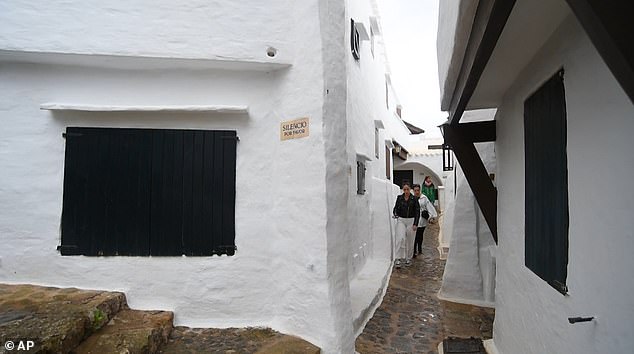
Recent images show the idyllic town almost completely deserted
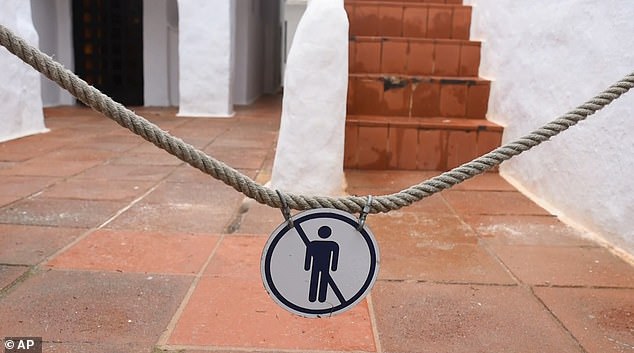
Óscar Monge, president of the neighborhood association, reproaches the Menorca authorities for not regulating tourism in the area and letting the locals take care of the matter.
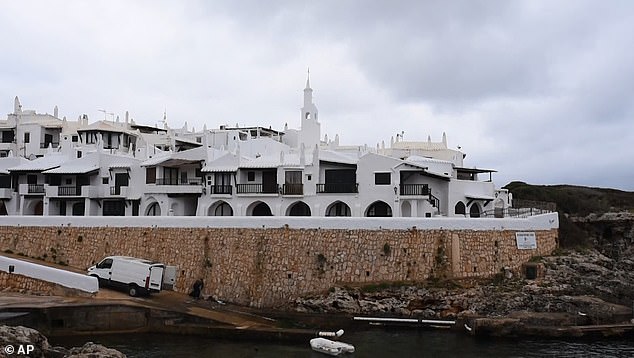
Binibeca only has capacity for 500 permanent residents in summer, but each year some 800,000 tourists flock to its pristine alleys.
In 2023, some 18 million tourists arrived on the islands, breaking a record for the archipelago.
And 14.4 million of them were foreign visitors, most of whom were Germans and British.
It comes as Brits heading to Mallorca this bank holiday weekend faced major disruption as thousands of people took to the streets in anti-tourism protests.
The protests took place on Saturday afternoon, starting at 7:00 p.m., and were centered in the capital, Palma.
Organizers said they were amazed by the number of groups and organizations that had pledged their support.
“At first we thought there would be about 2,000 people, but now it will be considerably more,” said a spokesman for the organizing group, Banc de Temps de Sencelles.
Last week, a group under the slogan ‘Més turisme, menys vida’, which translates as ‘More tourism, less life’, said they intended to cause chaos at Palma airport over the coming weekend.
Mes calls for a reduction in the number of flights at Palma airport: “Mallorca is no longer overpopulated, Mallorca is in collapse.” You can’t have airports that, year after year, break records.’
The Balearic Government says it is willing to change the tourism model and has started a round of conversations with citizens. So far no concrete measures have been agreed.
The Banc de Temps de Sencelles has titled its campaign ‘Mallorca is not for sale!’ and is so surprised by the promised support that he has asked the government to provide more buses and trains so that people from all over the island can attend.
“The demonstration aims to highlight the problem of access to housing in Mallorca, a general problem, but not isolated, because it cannot be separated from tourist saturation, from the purchase of properties by foreigners,” said Carme Reynés of the Banc de Temps de Sencelles.
The group says the protest will be followed by “other actions” in the coming weeks.
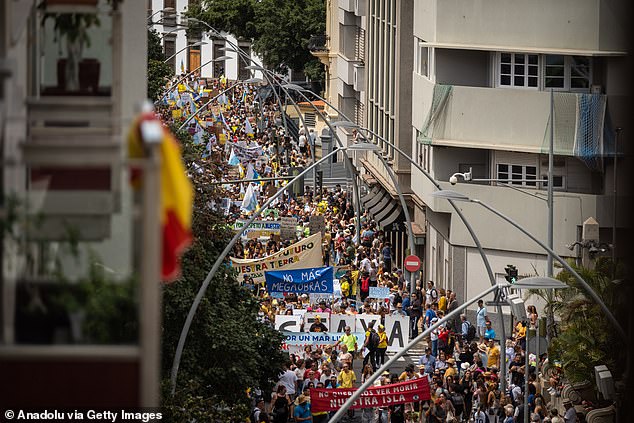
Protesters flooded the streets of Tenerife last month (pictured), calling on local authorities to temporarily limit the number of visitors to ease pressure on the islands’ environment, infrastructure and housing stock, and put brake on property purchases by foreigners.
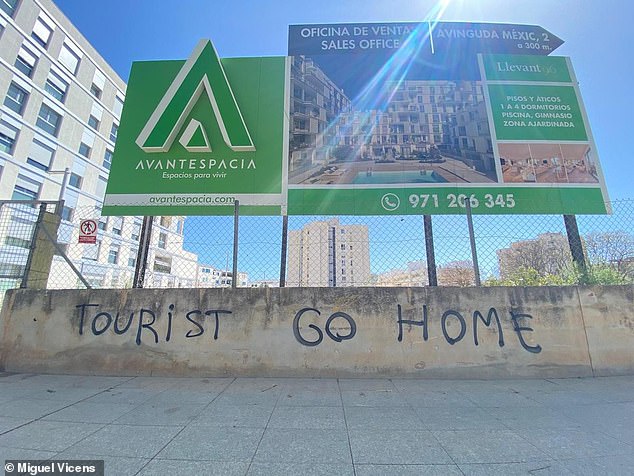
“Tourist Go Home” appears scrawled in English on a wall beneath a property development sign in Nou Levante, Mallorca, a neighborhood that has seen a massive influx of foreign buyers in recent years. It is one of the many cases of anti-tourism graffiti.
The protests in Mallorca come after more than 50,000 people took to the streets of Tenerife in April to protest against tourism on the Canary Island.
Protesters were seen brandishing banners reading “you enjoy, we suffer”, stating that the huge influx of tourists to the island is causing significant environmental damage, driving down wages and squeezing locals out of cheap and affordable housing, forcing dozens to live in tents and cars. .
British visitors to Tenerife will also be hit by a controversial “tourist tax” from next year, local authorities recently confirmed.
The proposal is part of the island’s new tourism strategy and is considered an eco-tax, but the level of the charge and formalities have not yet been agreed by Parliament.
It will apply to all of Tenerife’s most famous protected sites, including the Teide volcano and several rural parks and villages such as Masca.
A spokesperson for the Tenerife government said the introduction of this ecological tax was necessary due to the large increase in people visiting protected sites, both visitors and locals.
Travelers aged 16 and over already pay a daily charge of up to €4 (£3.45) when visiting the equally popular Balearic Islands such as Mallorca, Menorca and Ibiza.

